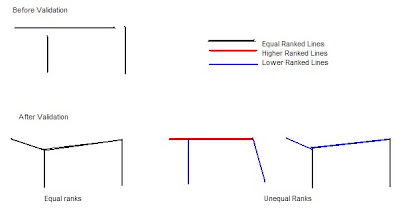
Ranks can be set to determine which lines will be snapped together. Higher ranked features will snap to each other before they snap to lower ranked features. This can be useful for snapping different classes of roads together or ensureing only data with the same accuracy levels snaps together. In the following diagram assume all lines end within the cluster tolerance.
 As a rule of thumb, cluster tolerance should be set 10 times smaller than the highest accuracy of your data. Therefor if your data was accurate to 10m your cluster tolerance would be .1m.
As a rule of thumb, cluster tolerance should be set 10 times smaller than the highest accuracy of your data. Therefor if your data was accurate to 10m your cluster tolerance would be .1m.Note: The date on this post should be October 28th, but pressing save instead of publish delayed the publishing of this post until now.
No comments:
Post a Comment